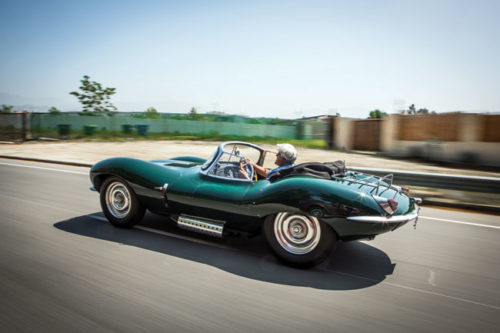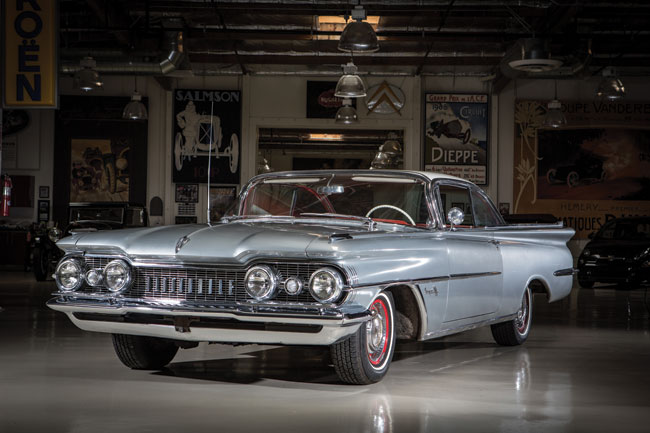
Jay Leno loves making people laugh and he loves cars. Those passions have shaped his life. After 22 years as host of The Tonight Show, he stepped down earlier this year but he’s working as hard as ever. When he isn’t traveling the globe performing stand-up gigs from Detroit to London and Rome, you can find him in his garage in North Hollywood getting hands-on with a multi-million-dollar array of perfectly maintained classic automobiles.
Leno’s affection for his four-wheeled collection — not to mention dozens of motorcycles — is on display every week in his hit Web series, Jay Leno’s Garage (nbc.com/jay-lenos-garage), on a YouTube channel that boasts nearly 1 million subscribers and draws 5 million views each month. Clad in his trademark denim shirt and jeans, Jay Leno drops one-liners on the series, but he also gets serious about his collection — whether he’s restoring a vintage Bentley, tooling down the highway in a classic Mustang convertible, or taking a souped-up Ferrari to the limit on a test track. He may be a famous face but that doesn’t keep him from rolling up his sleeves and going under the hood.
If you think driving around in one of his ultra-expensive supercars is an ego trip for Leno, you’ll be surprised to know him as I have. He’s among the least affected and most genuine celebrities in a town where the pursuit of fame can become toxic. If a kid happens to admire the Lamborghini Diablo Leno chose to drive for the day, Jay might just invite the kid to sit in the driver’s seat — with the car parked, of course. Whether it’s a car buff or a fan looking for an autograph, Jay takes time to chat.
His love affair with cars still takes a backseat to the real love of his life. Leno and his wife, Mavis, have been married for 34 years. What’s kept them together? Jay jokes, “Opposites attract. And when I come home late from the garage smelling of brake fluid, she knows where I’ve been.”

Watch the episode on Jay Leno’s Garage. (Photo by Dalton Walker)
Leno was a high school kid in his hometown, Andover, Massachusetts, flipping hamburgers at McDonald’s where he won first prize performing a comedy routine for the restaurant’s talent show. Later, he moved to Boston, worked at Foreign Motors car dealership, and dreamed of owning his first set of wheels before eventually embarking on a career as a stand-up comic. After years on the comedy circuit, he snared the brass ring in 1992 when hired to replace retiring late-night host Johnny Carson of The Tonight Show. Ratings success brought him big bucks, millions of fans, and a range of awards.
Now, Jay is adding one more trophy to the shelf. He’ll be the first top-rated late-night TV host to receive the coveted Mark Twain Prize for American Humor, joining such past honorees as Richard Pryor, Carol Burnett, and Bill Cosby. “I’m a big fan of Mark Twain,” he deadpanned. “A Tale of Two Cities is one of my favorite books.” (The event takes place at the Kennedy Center on October 19.)
We sat down on stools in the kitchen area of Leno’s impressive garage. The sound of motors being tested was background music.
Jeanne Wolf: You’ve never kept your love of cars hidden, but it’s especially evident in your Web show, Jay Leno’s Garage. You’re really having fun.
Jay Leno: The cool thing about the website is that it goes around the world. I guess my favorite part is that people get to see cars in motion. In car magazines you just see still pictures. Also, I’m not competing with something I’ve already done. No sitting behind a desk.
JW: And you’ve got a lot of viewers.
JL: It’s done quite well actually, and I’m thrilled with that — especially considering that it is all sort of word of mouth.
JW: Is love affair too strong an expression to use about America and cars?

JL: It’s a lot different than it used to be. I think the love affair is sort of over. When I was a kid in the ’60s and ’70s, car culture was pretty much what social media is now. You had songs like “Little GTO” and “Hey, Little Cobra” and “409.” Nobody sings about cars anymore. I was born the day I got my driver’s license.
JW: What was that day like?
JL: Your dad would teach you to drive. And, then, on your 16th birthday, you’d get your license, and you take your mom’s car out and try to go 100. I remember I was in my mom’s Falcon doing 96 … 97 … 98 – just barely trying to break it. I don’t think kids do that anymore. Now when kids want to get away, they can Skype in their room and see things they’re not supposed to see. When we were kids you physically had to leave your house, and the car was what took you to where the girls were or where things were going on or where the hangout was. In a lot of ways, the iPhone and social media have replaced the car. So I think that the love affair has dwindled but the hard-core romantics will keep it going.
JW: So you’re a hard-core car romantic?
JL: I like what it represents. The automobile is a piece of industrial history in America. It’s had a huge effect on our lives. When Henry Ford created the Model T, it was sort of the iPhone of the day. Before that cars were really just a plaything for the rich. When you buy an old car and fix it up and you drive it, there’s a bit more pride because you know what it took to get it running. That’s part of the romance. Modern cars are harder to bond with because they don’t break down. I’d say the American car dream is still around, but it’s not as big a deal.
JW: What was the first car that you owned?
JL: It was a ’34 Ford pickup truck. I got it when I was 14. We had a 300-foot driveway, and I would just drive up and down the driveway for hours at a time. When I got it, it didn’t run. My dad said if I could fix it then it’d be my car. You sort of learned to respect the machine and how to make it work. That’s probably what really got me into cars. And that’s what has kept me involved in creating my own collection and building the garage.
JW: When you were doing well and you could pick any car you wanted, did you buy something high-end?
JL: I never really bought any luxury cars when I first became successful. I got cars that I liked. The first real luxury car I bought was for my dad. I always told him that when I made it big I’d get him a Cadillac. So I took him down to Woodworth Motors in Andover, Massachusetts. My dad being Italian sees this big white Cadillac with red velour upholstery and, of course, he wanted that. So I buy him this ridiculous, garish white Cadillac, and my mother was embarrassed to ride in it. When they were driving down the street she would sit in the passenger seat, and if they pulled up to another car and people would look at it, she would motion them to roll down the window and say, “We’re not really Cadillac people. Our son got us this.” It was hilarious.
JW: What was the first expensive car that you bought for yourself because you really wanted it?
JL: I got a 1954 Jaguar XK120. There was a reason. When I was 9 years old, I was riding my bicycle in our town — where nobody had fancy cars — and I saw a man drive a 1951 Jaguar XK120 out of a barn. It was a little two-seater roadster, and I was mesmerized. He called me over — Don Milligan is his name — and asked if I’d like to sit in it, and I said sure. The car is parked in the same barn as it was in 1959. He still owns it.

JW: Is it a good day when you’re sitting in this huge garage tinkering with a car or trying to get it to run better?
JL: I love the challenge. That’s what we’re doing with that steam car over there. The gray and red one is called a Doble steam car. It was driven by Howard Hughes. We’ve been trying to get it up and running. The metal is 100 years old and things crack, so it takes a lot of work.
JW: How did you find that car?
JL: Old cars find you. I get letters every week from guys in their 70s, 80s, 90s who say, “Oh, I’ve had this car all my life. I don’t have any kids. I want it to go to a good home.” I always promise them that I’ll never sell it, which I don’t. That’s actually how I’ve acquired most of these cars, and they all have some sort of fascinating story behind them.
JW: How many cars do you have in here?
JL: I think about 128 and 93 motorcycles. Something like that.
JW: Do any new cars capture your fancy?
JL: Oh, very much so! I like the technology. I’ve got a Chevy Volt in here. I’m interested in some of the hybrid stuff that’s happening. Cars used to get 8 miles per gallon. Now they have three times the horsepower, and they’re getting 30 or 40 miles per gallon. The auto industry is still innovative. All of a sudden you’ve got the Tesla. When electric cars first came out they were slow, but they got pretty good mileage. Now you have the Tesla, which is electric and sexy and fast and luxurious. It has all the benefits of the gas car without a lot of the drawbacks. So, once again, engineers are making new things work.
JW: How about driverless cars?
JL: I’m not against them. I see driverless cars now — only people are at the wheel. They’re texting or talking or doing their makeup, or a guy is combing his hair. At least if a computer is driving it’s paying attention. I would rather have a computer driving than those idiots I see out on the freeway who think driving is so boring they’re doing something else.
JW: Don’t you want to share your love of cars with the younger generation even if they are into social media?
JL: I meet kids that remind me of myself when I was 15 or 16. Every now and then I’ll get a letter from one saying they’d love to ride in a certain car, so I invite them over and we go for a drive. I like to let kids sit in a car and grab the steering wheel and kind of feel what it’s like. I remember when I picked up my McLaren, there were two kids at the dealership just watching us. I invited them in, and they took pictures and sat in the car. They’ll remember that their whole lives the way
I remember Don Milligan for letting me sit in his Jaguar when I was 9.
JW: How do you pick which car to drive from this huge collection?
JL: It’s generally whatever I’ve been working on that day. You say, “Oh, that one’s fixed?” Then you test it, and hope it will hold up. When you deal with cars – and many of these cars are well-over 100 years old – something is always breaking. To me, how I get there is always way more important than where I’m going.
JW: A lot of people remember a car as the first place that they got to make out. Did you have any four-wheel romances?
JL: My wife, Mavis, and I did get romantic in my ’55 Buick that I still have next door. So on our 25th anniversary we took the car out and went back to that place where we had parked. There are a million houses there now, so we ended up in someone’s driveway around midnight. Then, of course, it was “Ow! My hair!” And I accidentally hit the horn. Of course. The light comes on on the porch, and a guy comes out. We were more successful the first time, but the basic idea was there.

Watch the June 8, 2014, episode on Jay Leno’s Garage to learn more.
(Photo by Walker Dalton)
JW: Ever bought a car on some crazy impulse?
JL: One holiday we go down to buy a Christmas tree. It was some ridiculous price, and I complained to the guy, but he said it was free delivery. I said, “OK. Fine.” So I buy it, and he asked me where I live. I told him Beverly Hills and gave the address, and he says, “Oh. That’s two miles out of the delivery zone. It’s gonna be an extra $50.” I was so mad. So I told him to wait. I went to the Chevy dealer across the street and bought a truck on the spot, brought it over, put the tree in the back, and drove it home. I still have the truck. That was the last time I did something that stupid.
JW: As a celebrity, do you always get great service from the valet?
JL: I hate valet parking. I’ll always look for a place on the street. You ever read the back of a valet ticket? No responsibility for damage. And if your car is stolen, the police don’t look for it for 30 days because you voluntarily gave the key to someone else!
JW: We’re all wondering what you’re gonna do next.
JL: I’m doing what I like. I like being a comic. I like going on the road. It’s kind of fun now that I’m not on TV. People don’t see you everyday. I might do something on TV — I don’t know what. I’m not gonna do another late-night show or something like that.
JW: Does it feel different?
JL: I know that some people when they leave a TV show they don’t have a table at a certain restaurant or whatever, but nothing has changed for me. It’s not like I’ve lost all these perks that went with being the star on a TV show.
JW: People wonder why you don’t seem to get angry or you aren’t meaner. You really seem to be a nice guy.
JL: There’s enough meanness. I mean when I look at TMZ and I see celebrities having feuds and it’s just “Eff you,” “No, eff you!” I don’t get that. If you’re in show business and you’re doing well, just thank your lucky stars. Peoples’ lives are hard enough without having to see a lot of negative stuff. I think when people see you and you’re a comedian, the first thing you should do is be funny. They don’t want to hear you whine or complain. I mean, you’re a rich guy and you’re getting mad? Shut up.
JW: Where did that attitude come from?
JL: I think it’s probably a little bit from having Depression-era parents. My mom came to this country by herself when she was 11. It was rough for her, so I always try to keep that in perspective. When I started The Tonight Show, it was originally The Tonight Show Starring Jay Leno and my mother said, “Oh, starring! Mr. Big Shot!” She always used to make me feel so guilty. I changed it to The Tonight Show with Jay Leno just so my mother wouldn’t think I was trying to be a big shot. The real trick is to make show-business money and lead a normal life. I can’t impress anybody in show business, but I can fix a car. Then I go home and they say, “The big meatball is for Jay. Jay gets the big meatball!” That’s when I feel like a big shot.
Become a Saturday Evening Post member and enjoy unlimited access. Subscribe now



